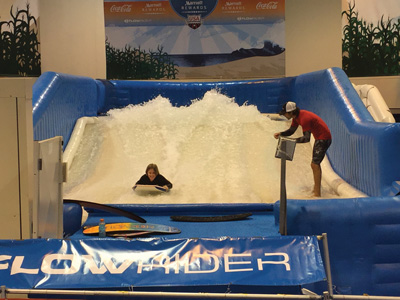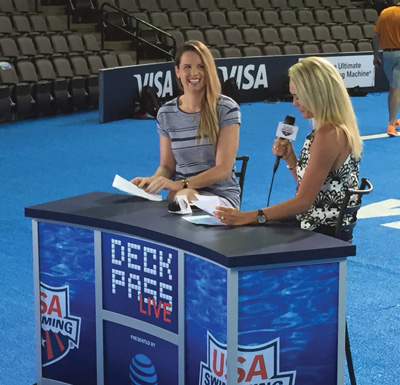The competition pool at the Olympic swim trials was closed for cleaning between sessions, but 10-year-old Meghan Knier was soaked.
She was next door at the Century-Link Center in downtown Omaha, Neb., learning to surf on a wave machine sponsored by Marriott Rewards in the USA Swimming Aqua Zone. Looking nervously at her mother, Knier let go of her instructor. She fell instantly, disappearing into the froth as her board flew. A second later, Meghan popped up with a big, shaken smile.
“She’s going over to the ‘Swim Like Michael Phelps’ thing next,” said Meghan’s mom, Jessica, as she toweled off. “This has been a great experience for both me as an adult and Meghan as a kid.”
For more than a decade, USA Swimming has worked to transform the trials from a utilitarian qualifier into a major sports and event property, trying to capitalize on the Michael Phelps era and draw vacationers like the Kniers. Seeing the progress, other Olympic sports are following their lead, looking for some beneficial pre-Rio attention and extra revenue.
 |
The collection of USA Swimming stars helped sell 220,000 tickets.
Photo by: GETTY IMAGES
|
For the first time, the U.S. Olympic Committee has stepped in with an umbrella branding effort and bundled sponsorship sales that cover swimming, track and field, gymnastics, diving and Paralympic trials.
“Trials helps immensely in the buildup to the Games,” said U.S. Olympic Committee CEO Scott Blackmun. “It focuses more attention on the athletes, and for many of them, it puts them in the spotlight for the first time. … It’s a very important asset for us, and one we never thought about globally until now, and [CMO] Lisa Baird deserves all the credit.”
USA Swimming’s third trip to Omaha was its biggest and most profitable yet, with about 220,000 tickets sold over eight days at prices ranging from $40 for the last day’s session to $1,100 for a front-row, full-meet pass. Scalpers worked the streets outside the sold-out venue, just a few blocks from the NCAA Men’s College World Series.
Driven heavily by a nearly 35 percent increase in attendance over 2012, the event expects a profit of between $1 million and $1.5 million on revenue between $8 million and $9 million, USA Swimming Executive Director Chuck Wielgus said. The governing body and its joint venture partner, Omaha Sports Commission, split the bottom line.
Add it all up, and you’ve got an event that’s grown far beyond its stated mission of picking a team into the dominant event on the domestic swim industry calendar.
Fundamentally, the swim trials have grown simply due to changes in qualifying standards. In 1996, fewer than 500 swimmers appeared at the trials, but the field grew to about 1,240 in 2000, peaked at 1,830 in 2012 and landed at 1,730 this year.
That sheer volume of activity has opened new marketing opportunities on-site. USA Swimming operated a hospitality house for the first time, copying a popular hallmark of the Games themselves, and serving as a home for sponsors and VIPs. The body’s new director of content, Tricia Vanderslice, directed twice-daily webcasts previewing and recapping the action, adding valuable sponsorship inventory. The Aqua Zone, in the convention center adjacent to the arena, occupied more than 100,000 square feet of space, featured autograph sessions with 40 Olympians and was a steady draw for fans.
 |
The #SurfOmaha feature at the USA Swimming Aqua Zone
Photo by: BEN FISCHER / STAFF
|
NBC Sports, which owns the rights to the trials under its larger Olympics deal, put new energy into the events this year. Including action earlier this year in other sports, NBC Sports aired an unprecedented 76 hours of trials, focusing on swimming, track and field, diving and gymnastics. The trials made prime time in 20 of the last 23 days ending July 10. Swimming ratings were mixed, but it put the sport and Omaha in valuable viewing windows, and on July 1, a marquee Ryan Lochte-Michael Phelps matchup led all sports broadcasts over the Independence Day weekend.
USA Swimming CMO Matt Farrell wants to use the trials to prove a point to sponsors: When the famous Olympians and the gold medals fade into history again after Rio, an upscale, family-oriented grassroots membership and fan base is still there — e.g., the Kniers.
“We try to use it as an anchor to a long-term partnership instead of a drive-by,” Farrell said. “We love for sponsors to see the people in the sport and realize it’s not a one-trick pony.”
Every USA Swimming sponsor except Chobani activated at the expo, with features like Speedo Plinko, virtual reality experiences from Blue Diamond almonds, Phillips 66’s hometown media booth for athletes to speak to small-market media outlets, and the Michael Phelps Swim Spa Challenge. For the first time since USA Swimming broke up its apparel category in 2012, after Speedo’s exclusive 27-year run, Speedo, Arena and Tyr shared a 20,000-square-foot retail space in the zone.
The convention center floor saw heavy foot traffic all week, and retailers reported brisk sales.
“The athletes are a big part of what we do in sports marketing, but when you engage the consumer at the level you don’t necessarily have the opportunity to do on a regular basis, it’s always a plus for us,” said Pierre Martin, Speedo’s vice president of marketing.
 |
Kara Lynn Joyce (left) and Kaitlin Sandeno discuss events on USA Swimming’s “Deck Pass Live” streaming show.
Photo by: BEN FISCHER / STAFF
|
Steve Ozmai, Arena North America’s director of marketing, agreed. With so many fans of a niche sport in one place, apparel makers have an engaged market for a much broader selection of product than they normally sell in retail stores. “For this one week, this is one of the best swim shops in the world,” Ozmai said.
Little of that overall marketing buzz would be possible without the huge crowds. The additional athletes competing has fundamentally altered the nature of the event, turning it from a relatively small elite meet to a flagship “gathering of the tribe,” as Wielgus calls it, that brings families of Olympic champions and rank-and-file club swimmers alike.
While some coaches grumble about the large number of swimmers who qualify for trials — two-time Olympic medalist Elizabeth Beisel broke her finger in a warmup pool collision in Omaha — Wielgus believes the swimming body has earned the benefit of the doubt after contributing the most medals to Team USA in six straight summer Olympics. “We don’t get a whole lot of pushback from our coaches on what our end result is,” he said.
Elsewhere in the Olympic movement, other sports are hoping to beef up their trials too. For instance, USA Gymnastics invited every living Olympic gymnastics veteran to a reunion at the women’s trials last week in San Jose, bringing hundreds more people into the venue, while USA Track & Field opened its first trials hospitality house this year in Eugene, Ore.
The USOC, which gives individual sport bodies a management fee to operate trials, has gotten more involved this year. Baird bundled marketing assets — venue signage, tickets, VIP hospitality, for instance — from track, swimming, diving and Paralympics, and then upsold to existing USOC sponsors looking for a bigger play. (The USOC owns rights within the competition venue; USA Swimming owns the marketing expo and the hospitality house.)
The USOC also dispatched its social media team to blanket Twitter, Snapchat and other platforms with coverage of the events and “Road to Rio” branding. The committee developed a series of digital documentaries with NBC timed to coincide with trials, and placed more Team USA branding in the venues, Baird said.
“We’re doing all this so people really see the breadth of what’s happening,” she said.
Both USA Swimming and the Omaha Sports Commission credit the event’s growth to their decision, reached at a meeting in Guam after the 2008 event, to create a joint venture to operate the event.
“The reality is then everybody has some skin in the game, and your decision-making is focused on the bigger picture rather than the end of the day,” Omaha Sports Commission President Harold Cliff said.
The close relationship has essentially ended the open competition and bidding for a home every four years. After tripling the rights fee it paid to USA Swimming from 2008 to 2012, the Omaha Sports Commission paid the same price for 2016. The parties would not disclose the fee.
“The value of the product has increased substantially, say from the time it was in Indianapolis or Long Beach to coming to Omaha, because of the number of people who can be exposed,” Cliff said.
With this year’s trials in the rearview mirror, the next big question is whether to stay in Omaha. Wielgus wants to. Cliff does too, and USA Swimming intends to work out a deal with Omaha before issuing an RFP. If a new deal with Omaha doesn’t materialize, the calendar will probably be to blame.
Temporary pool technology means the event could go almost anywhere in theory, but swimming experts want the trials to happen during a narrow window slightly more than a month before the Games. In 2020, the Tokyo Olympics will start two weeks earlier, pushing the trials into a direct conflict with the eight-team College World Series, just two blocks away from the trials’ home. (This year, the overlap was just with the finals.) Timing also puts any arena with a regular NBA or NHL season out of the running.
 |
The swimming trials have experienced big growth since coming to Omaha.
Photo by: BEN FISCHER / STAFF
|
Since heading to the CenturyLink Center in 2008, USA Swimming has considered going even bigger, taking a close look at bids that would have taken the trials to the Edward Jones Dome in St. Louis, the Alamodome in San Antonio, and even AT&T Stadium. “We were in Vancouver in 2010, and Jerry Jones comes over to me, and says, ‘Are you the swimming guy? We have to get you down to Dallas,’” Wielgus remembers. “But it was just too big.”
There is certainly unmet demand for tickets. But Cliff thinks they’d push their luck too far by going to a dome, and possibly lose some of the energy present during the nightly finals.
Also, organizers are well aware of the unique draw they have now — Phelps and Lochte, for instance — that may not always be there. “I’m not convinced in my mind bigger is going to sell more tickets. I don’t think if we had 25,000 tickets we would sell them,” Cliff said.
The swim trials may have caught lightning in a bottle, but the USOC wants to continue developing the business of trials wherever possible. And that includes expanding the high-stakes trial model into new sports, if appropriate.
“The trials are becoming more and more important to us,” Blackmun said. “More than half our athletes are selected in trials. It didn’t used to be that way, and we hope that percentage increases, not decreases. Selfishly, it’s a great asset that helps shine a light on the athletes well before the Olympic Games. With that said, there are some sports that just aren’t well-suited to trials.”







